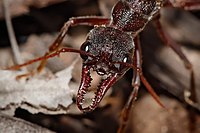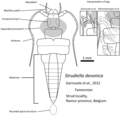Portal:Insects
The Insects Portal


Insects (from Latin insectum) are hexapod invertebrates of the class Insecta. They are the largest group within the arthropod phylum. Insects have a chitinous exoskeleton, a three-part body (head, thorax and abdomen), three pairs of jointed legs, compound eyes, and a pair of antennae. Insects are the most diverse group of animals, with more than a million described species; they represent more than half of all animal species. (Full article...)
Selected article -
The jack jumper ant (Myrmecia pilosula), also known as the jack jumper, jumping jack, hopper ant, or jumper ant, is a species of venomous ant native to Australia. Most frequently found in Tasmania and southeast mainland Australia, it is a member of the genus Myrmecia, subfamily Myrmeciinae, and was formally described and named by British entomologist Frederick Smith in 1858. This species is known for its ability to jump long distances. These ants are large; workers and males are about the same size: 12 to 14 mm (0.47 to 0.55 in) for workers, and 11 to 12 mm (0.43 to 0.47 in) for males. The queen measures roughly 14 to 16 mm (0.55 to 0.63 in) long and is similar in appearance to workers, whereas males are identifiable by their perceptibly smaller mandibles.
Jack jumper ants are primarily active during the day and live in open habitats, nesting in bushland, woodlands, and dry open forests, surrounded by gravel and sandy soil, which can be found in rural areas and are less common in urban areas. They prey on small insects and use their barbless stingers to kill other insects by injecting venom. Other ants and predatory invertebrates prey on the jack jumper ant. The average worker has a life expectancy of over one year. Workers are gamergates, allowing them to reproduce with drones, whether or not a queen is present in the colony. The ant is a part of the Myrmecia pilosula species complex; this ant and other members of the complex are known to have a single pair of chromosomes. (Full article...)Did you know -
- ... that the extinct Phlebotominae sandfly Pintomyia falcaorum is known only from Miocene age Dominican amber found on Hispaniola?
- ... that although true bugs eat aphids, they help the aphids by eating another predator, young lacewings?
- ... that the ground beetle, Lebia grandis, can eat about 23 eggs or three larvae of the Colorado potato beetle every day?
- ... that the weevil Hylobius transversovittatus has been introduced into the United States and Canada to help control the invasive wetland plant Lythrum salicaria (purple loosestrife)?
- ... that the larva of the Texas beetle, Brachypsectra fulva, can live for over two years without feeding?
List articles
Related portals
General images -
Selected image -

Reduviidae (Hemiptera) is a large, cosmopolitan family of predatory insects, including the assassin bugs (genera include Melanolestes, Platymeris, Pselliopus, Rasahus, Reduvius, Rhiginia, Sinea, Triatoma, and Zelus), wheel bugs (Arilus cristatus) and thread-legged bugs (the subfamily Emesinae, including the genus Emesaya). There are about 7,000 species altogether, making it one of the largest families in the Hemiptera.
WikiProjects

Main WikiProject:
Related projects:
- WikiProject Arthropods
- WikiProject Spiders
- WikiProject Animals
- WikiProject Tree of Life
- WikiProject Biology
Daughter projects:
Tasks
 |
Here are some tasks awaiting attention:
|
Associated Wikimedia
The following Wikimedia Foundation sister projects provide more on this subject:
-
Commons
Free media repository -
Wikibooks
Free textbooks and manuals -
Wikidata
Free knowledge base -
Wikinews
Free-content news -
Wikiquote
Collection of quotations -
Wikisource
Free-content library -
Wikiversity
Free learning tools -
Wiktionary
Dictionary and thesaurus




















































